Fall 2015 A publication of the Wildlife Division—Getting Texans Involved
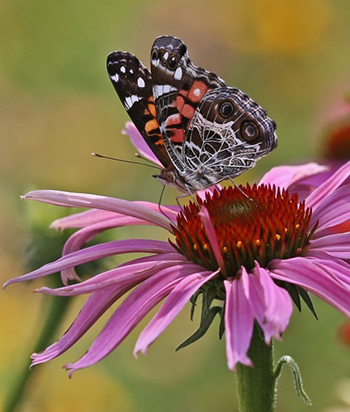 Urban Butterfly Gardens
Urban Butterfly Gardens
By Dr. Cathryn A. Hoyt
We are lucky in Texas. We have over 400 different types of butterflies here—that’s over half of the butterflies seen in the United States! Most are pretty much permanent residents, others hop the border from Mexico occasionally to stun butterfly enthusiasts and cause a stampede of butterfly watchers to the borderlands.
I will confess that I'm a stampeder. Any word of a rarity and I'm off to join the herd. As we search each and every flower, peer under leaves, and poke cameras in the general direction of the reported rarity, my fellow butterfly watchers and I talk. "There just aren’t as many butterflies anymore," I hear. "Fifty years ago, these were common," they say. "Where have all the butterflies gone?" we wonder.
Sadly, butterflies are disappearing as urban areas sprawl, roadsides are kept weed-free and mowed to the ground, and we demand perfect fruit, vegetables, and containers of flowering plants.
There is something you can do about it though. Take a moment and look outside. Do you have a yard? A balcony? With a tweak here and a twitch there you can turn your space into an open invitation for many different types of butterflies.
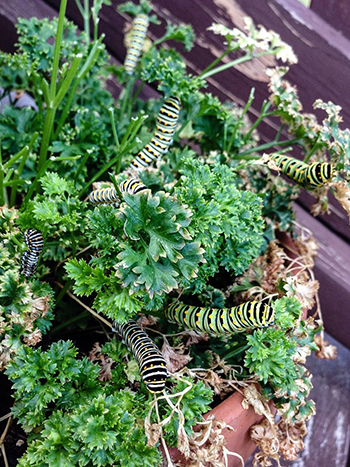
Think Texture
Butterfly species are all different. Some like to soar through the treetops, others bebop along the ground. If you want to attract the maximum number of species to your garden, plan for different butterfly habits. Think about vertical texture and mix your planting up with trees, shrubs, annual or perennial flowers, and even grass.
Also give some thought to horizontal texture-horizontal in terms of time. When do your plants bloom? When do they leaf out? Select plants that will bloom from the spring through the fall to attract the most butterflies.
Get wild and crazy
Native plants attract native butterflies, it’s that simple. Do some research and find out what types of butterflies occur in your region and what kind of native plants they're attracted to. Butterflies actually need two types of plants: nectar plants that provide food for the adults and host plants that provide food for the caterpillars. Choose both and you're sure to attract a greater diversity and number of butterflies.
Finding native plants can be a bit of a challenge. Start by seeking out your local native plant nursery. They’re usually run by people that are absolutely passionate about native plants and can give you lots of advice. Be sure to watch for native plant sales run by your local Master Gardeners, Native Plant Society, or Master Naturalists. Sign up for a seed-collecting workshop and learn how to responsibly collect seed from wild plants. Participate in a plant swap. There are a lot of native plant and butterfly enthusiasts out there to help you learn.
Go Ahead, Get Messy
Butterflies like messy gardens. Dead branches make great perches. Bare patches of ground are wonderful places to get together with some of your BFFs and have a puddle party. To ward off the chill of winter, there's nothing quite like a blanket of leaf litter. So let go of that "perfect garden" concept and let things get a little messy.
While you're at it, be a little more tolerant of weeds. While adult butterflies sip nectar from many different types and colors of flowers, they're a lot more discriminating about where they lay their eggs. These host plants are often not as showy as nectar plants and some look like, well, weeds. But if you can overlook a little mistletoe in your oak tree, you may attract great purple hairstreaks and some pigweed may bring scallopwings to your yard. Those irritating tansy mustards? Let them grow and you'll enjoy checkered whites flitting through your garden looking for the perfect tansy mustard to lay eggs on. Again, do some research and wisely choose your weeds.
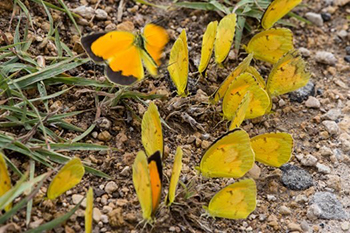
Be Pesticide Free (This is Harder Than you Think)
Go ahead. Go to your favorite garden center and stand in front of the wall of pesticides. Then, just walk away. You’ve saved yourself a lot of money and probably thousands of butterflies, moths, bees, birds and other wildlife. Yes, the caterpillars are going to chew holes in your plants, but that’s what the plants are for. Rejoice!
Being pesticide free can be more difficult than you think. Many of those beautiful annuals sold by the millions in box store garden centers are riddled with pesticides. That's why they're so beautiful. Neonicotinoid pesticides are systemics that are absorbed into the roots, stem, leaves, flowers, nectar, and pollen of the plants. This is not good for butterflies, bees, or anything else for that matter.
I learned this lesson the hard way last year. A crop of black swallowtail caterpillars had eaten my small pot of parsley down to the ground, so in desperation, I went to the grocery store and bought bunches of parsley to feed them until they reached the chrysalis stage. Within 24 hours, the caterpillars were dead. To learn more about neonicotinoids, visit the Xerces Society website.
Get Gross Not all butterflies are nectar feeders. Some feed exclusively on rotting fruit, carrion, or sap from trees. While leaving carrion in your garden may be taking your devotion to butterflies a bit far (and will probably offend the neighbors), you can enhance your butterfly garden with a simple butterfly feeder.
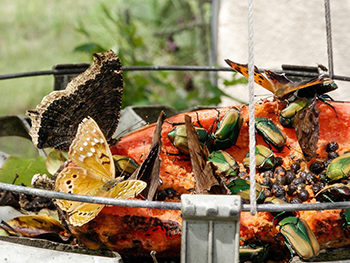
Take a large, flat dish and suspend it from the branch of a tree. Place rotten bananas, the rind from melons or other overripe fruit in the dish, and watch the butterflies come. Fruit feeders include the glorious red-spotted purple, mourning cloaks and hackberry emperors. You may see butterfly houses advertised in garden catalogs. These are pretty, and they're fun, but there's no real evidence that butterflies will use them. Save your money, and buy more rotten bananas.
Shake, Rattle, and Roll Now that you've started a life list and find yourself spending countless hours watching butterflies in your yard, it's time to think ahead. Do you want your grandchildren to enjoy this simple pleasure? Get involved! Offer to help your neighborhood school plant a butterfly garden. Get a group together to encourage developers to landscape with native plants. Support your native plant nurseries. Have your garden certified as a Wildscape, Best of Texas Backyard Habitat or a Monarch Waystation. Reach out, share your passion, and ensure that butterflies will be a part of everyone’s future.
Dr. Hoyt is a nature writer and photographer from Fort Davis.
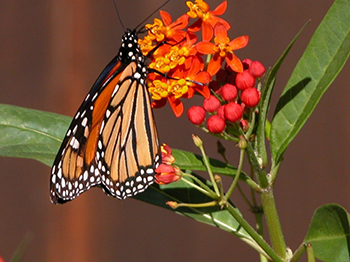 Texas' State Insect Needs Texans
Texas' State Insect Needs Texans
By Ben Hutchins
Every fall, monarchs from the northern United States and southern Canada make the most spectacular journey of any invertebrate. Travelling as far as 3000 miles over the course of several months, these long-distance fliers make their way to a few isolated patches of forest near Mexico City, where they spend the winter in incredible roosts, covering the trunks and branches of Oyamel fir trees. However, over the last two decades, researches have watched as the size of these roosts have dwindled from an all-time high of nearly 45 acres in the winter of 1994-95 to an all-time low of less than 2 acres in the winter of 2013-14. Researchers believe that this decline is the result of multiple factors including illegal logging of the Oyamel forests, multi-year drought in much of the United States, winter storms in Mexico, and large-scale loss of milkweed and nectar-producing plants.
It is this loss of milkweed and nectar-producing plants, primarily in the mid-west United States, that has monarch conservationists particularly concerned. Large-scale agriculture has spread at the expense of native grasslands and prairies that are so important to the monarch's survival. Widespread adoption of Roundup Ready crops (genetically modified crops that are resistant to the broad-spectrum herbicide glyphosate) has allowed increased use of glyphosate, which has resulted in additional loss of milkweed and nectar-producing plants that may have persisted in the crop rows and along field margins.
In Texas, a relatively small proportion of the landscape is planted in one-crop agriculture, so land managers don't think that glyphosate use threatens monarchs in Texas to the extent that it may in other states. Nevertheless, Texas’ once extensive prairies and grasslands have faced a number of other threats including urban sprawl, woody encroachment due to fire suppression, the spread of non-native grasses, and degradation due to poor rangeland practices (to be clear, good rangeland management can be practiced in a way that maintains the ecological integrity of prairies).
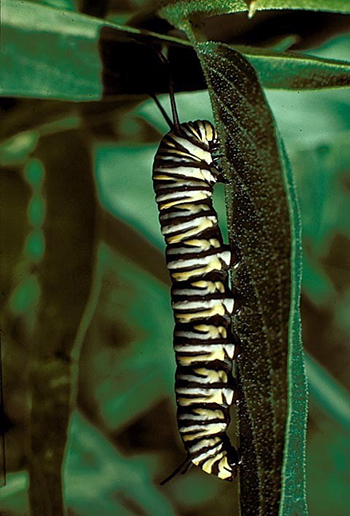
To restore Texas’ prairies, TPWD biologists and experts from other state, federal, and non-governmental agencies are working with landowner’s at the landscape scale. But what about Texans that don’t own a farm or ranch? Well, because monarchs undertake a fall, southbound migration and a spring, northbound migration, chances are that if you live along the migratory corridor, a monarch butterfly may pass by your front door, looking for an opportunity to refuel or deposit eggs. In Texas, the migratory corridor roughly corresponds to I35, give or take a couple hundred miles on either side.
If you live in that broad swath of land, a garden or flowerbed that includes milkweed and nectar-producing plants can be a potential boon for migrating monarchs. Monarch caterpillars feed exclusively on milkweeds and milkweed vines, and while over 37 species are native to Texas, there are a few choices that are particularly appropriate for cultivation. These include butterfly weed (Asclepias tuberosa), antelope horns (Asclepias asperula), green antelopehorn (Asclepias viridis) and zizotes (Asclepias oenotheroides). Butterfly weed occurs throughout most of eastern Texas in sandy soils, but it has few of the natural toxins that provide monarch caterpillars with a good defense against predators. Antelopehorns is native to the Edwards Plateau and much of the Blackland Prairie, where it grows best in rocky and sandy soils. Green antelopehorn occurs throughout much of the eastern half of the state, preferring full sun and tolerant of a variety of soil conditions. Zizotes is common throughout much of South Texas and parts of the Edwards Plateau and Blackland Prairie, where it can be found in calcareous and tight sandy clay soils.
These milkweeds are sometimes available at local nurseries as young, potted plants. Because of difficulties associated with raising milkweed from seeds, young plants are your best bet. However, if you can,t find young plants for sale, the Xerces Society, a non-profit conservation organization, has developed an online tool where users can search for seed providers by state and species. If you want to grow native milkweeds from seed, there are several tricks you can use to increase your chances of success. These include using a period of cold, moist stratification (basically keeping the seeds in a fridgerator with moist vermiculite), and planting the seeds in a deep container (most species have a long taproot). Finally, be patient: it may take a milkweed several years to reach reproductive maturity.
The milkweed most commonly found in nurseries is the non-native, tropical milkweed (Asclepias curassavica). Researchers have expressed concern that widespread cultivation of this admittedly beautiful plant may actually be detrimental to monarchs by increasing infection rate by a protozoan parasite, and by causing migrating monarchs to reproduce in the winter when they should be migrating. We do not recommend this plant. If you do decide to plant tropical milkweed, cut the plants back and trim newly sprouting leaves throughout the late fall and winter, so that the plant is unavailable for use by southbound monarchs.
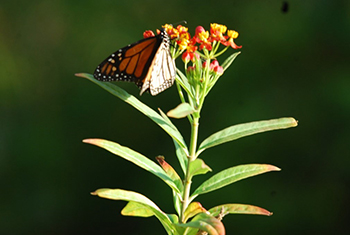
Although milkweed planting is the most commonly cited action for monarch conservation, planting of native, nectar-producing plants may be even more beneficial. Both northbound and southbound migrating monarchs need the energy provided by nectar, and not only are nectar-producing plants beautiful, but they benefit a diverse host of butterflies and native pollinators When choosing nectar plants for monarchs, it's important to provide plants that bloom in spring and fall so that northbound and southbound monarchs will have nectar. A few examples of native, spring blooming plants that attract butterflies include Indian paintbrush, Indian blanket, pink evening primrose, and pincushion daisy. A few examples of native, fall blooming plants include frostweed, gayfeather, Maximillian sunflower, and common sunflower.
Only time will tell whether conservation efforts from Mexico to Canada can reverse the downward trend in monarchs. Landowners in Texas can play a particularly important role in helping this iconic species recover. Regardless of the size of ground that you have to work with, take pride in the native, monarch-friendly plants that you can maintain, knowing that you are part of a nation-wide effort to preserve the monarch migration for future generations.
Ben Hutchins is the invertebrate biologist for the State of Texas and works out of Austin This article was originally published in the Green Team newsletter at Texas Parks and Wildlife.
Creating a Demonstration Area
By Mimi Mancuso
The decision was made to construct an example of a backyard garden to demonstrate to the public. The garden is part of the grounds surrounding the information center at the Fort Worth Nature Center. It is fenced and already had a pond surrounded by rocks in front of the window situated where the garden would be viewed from a classroom area. There are four garden areas with large trees, many birdfeeders and a rail fence surrounding them. We left a brush pile behind one garden to offer shelter for native critters. Criteria included presenting native plants, water restrictive, using no chemicals, plants that provided food for the birds and to encourage pollinators. We collected seeds from plants around the nature center property, planted them in growing mediums in the nature center greenhouse, repotted as necessary, recorded data along the way and replanted in the garden area when appropriate. We are now able to have the public see what would grow in their own gardens without an abundance of water or constant tending. We also provide examples of not only native plants, but plants that will be good for the ecosystem. This project did not take anything in the way of funding because everything came from the property and the manpower was volunteers.
Mimi volunteers at the Fort Worth Nature Center
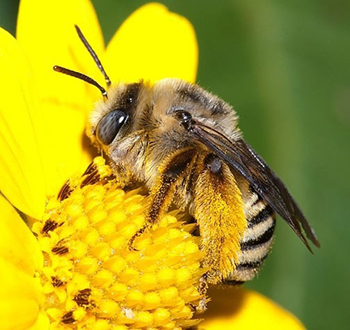 Solitary Bees: Unappreciated Majority
Solitary Bees: Unappreciated Majority
By Michael Warriner
The qualifier "solitary" means that individual female bees are solely responsible for the establishment and provisioning of their own nests. There are no daughter workers to help these single mother bees in their labor. In fact, adult female solitary bees do not generally live long enough to see their eggs develop into the next generation of adults. As with social bees, male solitary bees play no role in nest construction or food acquisition; only transferring sperm to females during the act of mating.
The majority of solitary bees are ground-nesters that excavate burrows in well-drained, sunny patches of bare-ground. Ground-nesting species may occur in large aggregations noticeable through the presence of dozens of small holes surrounded by mounded piles of dirt. The remaining contingent of solitary bees nests in existing cavities in dead wood (generally galleries left by wood-boring beetle larvae) or chew their own cavities into woody material. There are even a few solitary bees that nest in discarded snail shells and dried cow dung. During the spring and summer months, female solitary bees provision nests with food (lumps of pollen mixed with nectar and saliva), lay eggs, tightly sealing the nest upon completion. Females may establish multiple nests over their adult lives that may span several weeks up to a few months. After a nest is completed, females move on to the next nesting opportunity never to revisit or safeguard their previous work. Their eggs and the resulting larvae feed on the stored food, overwinter inside the nest, and emerge the following year as adults to begin the cycle again.
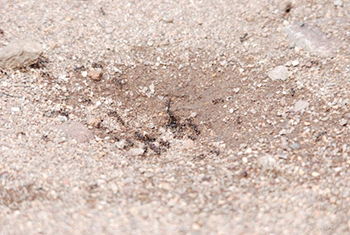
No Home Defense
Many people have the mistaken belief that all bees exist in the form of enormous colonies of swarming, mass-stinging insects. Since they lack a workforce of adult offspring, solitary bees do not display the same propensity to defend their nests as do social bees. Unlike bumblebees and honeybees that possess security forces of defending daughter workers, female solitary bees are sole caretakers and simply cannot afford the risk of injury or death that comes with driving off those that menace their nests.
Although female solitary bees may sting if stressed by being purposefully caught in hand or accidentally pressed against skin (trapped in clothing), they do not launch attacks to defend their nests. Their benign nature makes the nests of solitary bees safe to approach. Lack of defensive behavior at the nest also makes them a better option for those interested in promoting bee populations in suburban/urban gardens, parks, and home landscapes.
Staggering Diversity
Texas is home to an incredible array of solitary bees. Just under 650 described species have been documented from the state. That number is likely a gross underestimate of Texas’s actual solitary bee diversity. Given the state’s size and the very few native bee researchers working here, there are likely many bee species that have yet to be scientifically described.
Most of our solitary bees are relatively small (though, there are a few really large solitary bees) and often less frequently observed than their social cousins. They may even be hard to identify as a "bee" given their wide range of shapes and color patterns. Although less well-known, solitary bees such as carpenter bees (Xylocopa), digger bees, (Centris), leaf-cutter bees (Megachile), longhorned bees (Melissodes), mason bees (Osmia), mining bees (Andrena), squash bees (Peponapis), sunflower bees (Diadasia), and sweat bees (Agapostemon) just to name a few, are responsible for a significant amount of pollination in agricultural and ecological systems.
Michael is Supervisor of the Non-game Program. This article was originally published on Texas Native Bee Coop website.
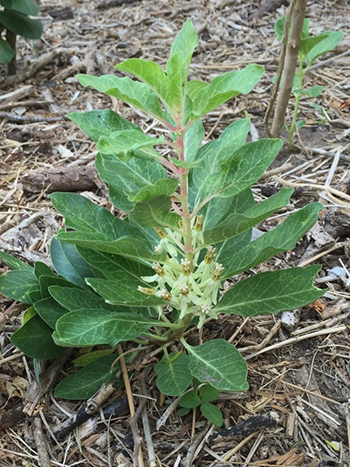 The Laughing Garden and other happy happenings at Harlingen's Hugh Ramsey Nature Park
The Laughing Garden and other happy happenings at Harlingen's Hugh Ramsey Nature Park
By Anita Westervelt
But the specialty gardens and trails were in danger of disappearing. The Old Guard - those who planned, researched native flora, rescued plants, and planted and tended the native trees, shrubs and plants - could no longer provide the labor force required to maintain the gardens as they had done for more than a decade. Thanks to a team effort, the park is getting an overhaul. Last fall, RGVCTMN members resurrected a Ramsey Park advisory committee that included three of the original volunteers. The objective was to estab lish an energetic workforce to carry on the native tradition of the park.
Initially, committee members located rare plants, assessed current garden conditions and documented all native plants in the park. The Old Guard was readily willing to share their wealth of information. The challenge was how to impart that knowledge and history of the park to a new crew. To do that, they established goals, tasks and priorities to provide mentorship and direction for a new team.
Happily, ten trainees from the chapter's 2015 winter training class volunteered to take up the mantle. Training began in February by clearing a selected area thick with rambling thorn brush, dead limbs and giant, trail-encroaching Texas prickly pear cactus, Opuntia engelmannii. The group hacked away until nothing was left but rich, friable soil. The learning experience included an intimate introduction to the flesh-tearing thorns of granjeno, Celtis pallida, and the annoying amount of spines on a prickly pear pad. It also included the grueling eradication of invasive guinea grass, Urochloa maxima, the practicality of forest brush piles, and clearing over- growth to allow important species to thrive instead of competing with aggressive scrub for nutrients, space and sun.
Within weeks, the cleared area was revegetated with native species to provide butterfly nectar throughout the year. Because there was so much laughter involved in the preparation, the new group named their garden, The Laughing Garden. With its accomplishment, they began a systematic sprucing of adjacent gardens around the park's south side Ebony Loop.
With drenching spring rains in the Rio Grande Valley came rapid and massive growth along Ebony Loop. Those familiar with the movie, "Little Shop of Horrors," might imagine that the plot was inspired by the growth along Ramsey Park’s main southern trail after several healthy storms. Although the park was magical with lush growth and colorful blooms after a devastating three-year drought, navigating to work sites became nearly impossible. New-growth branches of mesquite, Prosopis glandulosa; granjeno; and Colima, Zan- thoxylum fagara, tendrils of vines; and colonies of native lantana, mist flower, mallow, dicliptera and cactus growing through the caliche path hindered mobility.
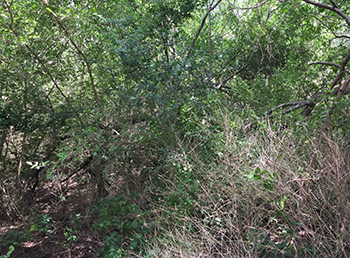
Tackling thorn scrub and widening trails entails clearing, pruning and trimming using loppers, hand saws, chainsaws, garden clippers and thick gloves. Also necessary is removing enormous amounts of debris, including low hanging dead limbs. Whether building off-trail brush piles for critters, dis- tributing green mulch to various areas or tucking limbs and debris beneath the understory, all methods create unique ecosystems that happily rot away, eventually improving the soil.
A Monarch-specific garden was created by a chance happening. It features 20 zizotes plants, Asclepias oenotheroides, donated by a local native plant grower who happened to be walking through the park while the group was clearing an area near a bird blind. The team is particularly excited about this new garden. One of the goals was to establish colonies of this hard-to-find Rio Grande Valley native plant, and locating plantings had been unsuccessful. After planting and watering in, the zizotes established very quickly, blooming by the next week and began to form seed pods.
The area, named Zizotes Circle, had been cleared of dense overgrowth. The initial objective was to revive the park’s original bird blind and clear the paths to it. Across the trail from Zizotes Circle, and now visible from the blind, is a savannah of spring, summer and fall-blooming butterfly nectar plants: lantana, mist flower, American germander, heliotrope, sunflower, cow pen daisy, bush morning glory, and vines of milkweed and passion flower, leading to the Arroyo Colorado River. It is rife with Mexican Bluewing, Queen, Julia Heliconia, Sulphur and Monarch butterflies. The park also hosts pockets of two species of milkweed vine, climbing milkweed, Funastrum cynanchoides, and talayote, Cynachum racemosum .
Volunteers continue to unearth specialty plants like Indian heliotrope, Heliotropium indicum, basket flower Plectocephalus americanus and heartleaf hibiscus, Hibiscus martianus that need continuing protection from more common plants, especially guinea grass, and the native but aggressive Dicliptera sexangularis. Tasks are defined to maintain volunteer interest, offer variety and provide structure for the volunteers. New goals crop up and the committee strives to remain fluid, changing with weather conditions, interests and abilities and ideas of the workers.
Thanks to the new team and a handful of long-term volunteers, a noticeable dent has been made in their list of goals. Many plant specimens have been moved from pathways within Ramsey Park to newly-cleared areas ready for re-vegetation. Bird blinds have been revitalized and the surrounding areas rejuvenated keeping bird-watcher and photographer points-of-view in mind. Trained volunteers have made it possible to achieve goals which were unattainable for the past several years. A recent example is the clearing of competing mesquite from one of only two rare barreta shrubs, Helietta parvifolia, in the park.
Guided walking tours have been re- established and the new team we trained to lead. Plant identification is ongoing. New water features are being constructed and volunteers continue to be added to the ranks. Seed collecting will be an important fall project. The park's gardens are ready for October butterfly migration and Harlingen’s annual Rio Grande Valley Birding Festival in November.
Anita is a freelance photojournalist as well as president and Outreach chair for the Rio Grande Valley chapter of the Texas Master Naturalists.
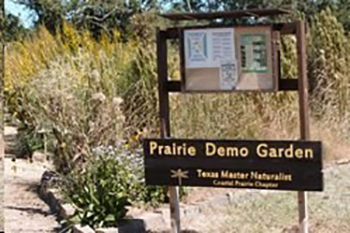 Urban Milkweed Sustains the Monarch Migration Phenomenon
Urban Milkweed Sustains the Monarch Migration Phenomenon
By Barbara Keller-Willy
Grant money has been awarded to scientists, government agencies and nonprofits to study the issue and create implementation plans to save the monarch migration process. As people work at various levels to determine the most effective actions we can take, communities, organizations, citizens and enthusiasts have begun growing milkweed (Asclepias sp.), the only plant upon which the monarch lays eggs and the caterpillar eats.
Texas is uniquely important as all migrating monarchs travel through Texas during both the spring migration from and the fall migration to the mountains of Mexico. In the spring, monarchs arrive in Texas to mate, then find milkweed colonies where they can lay eggs, creating the next generation of monarchs that migrate northward. In the fall, the monarch, traveling about 55 miles per day, falls out at the end of each days’ flight seeking nectar and water to replenish the weary travelers as well as trees where they can safely roost overnight. They repeat this process daily until they arrive at their destination in Mexico.
We know that monarchs use the same central or coastal corridors utilized by other migratory species. Wind direction, weather and plant availability play important roles in choosing where to stop along the migration route or where they are temporarily forced to the ground. Texans along these corridors are participating in efforts to preserve monarch migration by ensuring the availability of milkweed and nectar plants along the migration corridors.
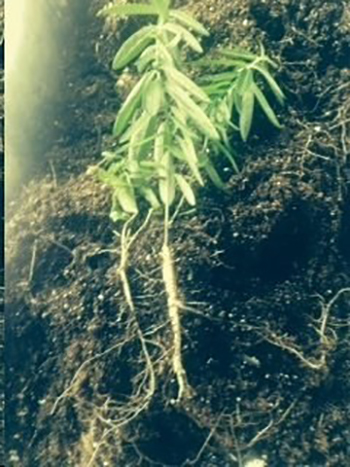
Though approximately 37 different species of native Texas milkweed exist, not all are suitable for or desired by the monarch and her caterpillar. By focusing our growing efforts on several key milkweed species for each different region along the migration corridors and ensuring the native high quality nectar plants they seek when migrating are also available, we can create high quality habitat.
Our native milkweeds have a reputation for being "notoriously difficult" to grow. Many of our milkweed, even those that thrive in very dry conditions, begin their lives as spring seedlings when rain is abundant. This years’ wetter than normal conditions produced a bumper crop of seedlings that are just now rising above summer companion plants. If we understand the normal growing conditions of the milkweed we seek to propagate and create similar artificial conditions, our percentage of successful germination will be greater. Not only does native milkweed enter dormancy in the winter, but stressors like extreme summer heat, lack of water or an infestation of pests like aphids can cause a mid-season dormancy.
With the range of ecosystems represented in Texas, many species of milkweed will only grow in their native region. We can grow milkweed from almost any region in greenhouse conditions but if you try to introduce the species to another range, it may not be able to withstand the level of humidity, high daytime temperatures or arid conditions. Unless you are growing milkweed for a project in its native region, always collect or purchase seed for your local area to ensure healthy propagation and life of the plant. Plant germination begins with the seed collection process.
Always ensure seed collected is ripe and ready to be picked. If seed was not ready to be picked it will not germinate. This is a frequent reason for unsuccessful germination. If collecting seed yourself, choose pods ready to open and avoid bug infested pods. All seed must be separated from the pods and silk then stored in a clean dry, dark place. Purchase seed from Texas vendors to ensure the seed is capable of withstanding our heat and humidity and collect local genotype seed within a 50 mile radius for the most successful germination rate.
Milkweed germination methods can be found on the internet. Better germination can be gained through the use of stratification, the artificial simulation of winter cold followed by milder spring bloom temperatures. In nature some seed may germinate immediately while others germinate later or in following years. Stratification can help force all seeds to germinate at the same time, an important goal if you are growing plants for a specific project date.
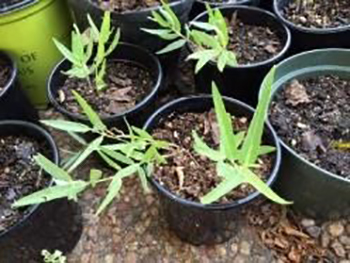
In the first year of germination, it is most important, that the seedlings are watered consistently. Success is dependent upon establishing the correct water management for your size container and the degree of sun exposure. Soil must be kept moist. Lack of enough water at consistent intervals is the number 1 reason for loss of milkweed plants. Mature milkweed plants have tap roots the size of a small carrot that hold moisture in the plant allowing it to survive our harsh heat. Seedlings have a small tap root vascular systems that grow deep but not very wide and the plant will dry out quickly if not watered regularly. Both Green milkweed (Asclepias viridis) and antelopehorns (A. asperula) grow in meadows and ditches that are very wet in the spring during the seedling growth process. Replicate this wet feet in the spring to give your seedlings their best shot at healthy first year growth.
While milkweed germination instructions exist on the web today, there is not much information available on how to keep plants alive until a tap root is large enough to sustain the plant. By teaching urban participants those tips, we foster the successful participation of the communities where milkweed implementation is needed.
Many different teen organizations including Girl Scouts and Boy Scouts are not only growing milkweed but designing, creating and maintaining monarch habitat to attain their organizations' highest honors.
While milkweed will grow best when planted in deep pots, it can and does grow in whatever containers one has on hand. Participants delivering just a few milkweed to a project in their community can be very effective with very little effort if they are taught growing tips.
By teaching community gardeners and organizations with restoration projects to grow native milkweed we can establish natural milkweed colonies on large acreage restoration where the perfect microbial conditions likely already exist. With this participation we gain the larger critical mass required for the large groups of migrating monarch. When combined, these projects make a large scale difference.
Attend the Texas Native Milkweed Symposium, scheduled for San Antonio in January 2016, We target experienced growers, Horticulturists, botanists, agencies and non-profits to share lessons learned and create an urban implementation plan among participants. In this way, milkweed efforts can be coordinated to achieve the larger flyway goals the Monarch needs for preservation of its migration phenomenon!
Barbara Keller-Willy is Director of Monarch Gateway, a non-profit dedicated to the preservation of all pollinators.
Back Porch 
By Mark Klym
This question reflects a basic misunderstanding of how our ecosystem works and how extremely interdependent species are. To use the example above, when one species is lost from an ecosystem - whether it is a plant or an animal—every species that uses that species or is used by that species is impacted. If a milkweed species - to use a plant that has been talked about extensively in this publication - goes extinct then the monarch and other species whose caterpillars feed on the milkweed are impacted. Not only them, but the insects and other animals that use monarchs at various stages of their lives are also impacted. The plants that depend on the monarch as one of their pollinator species are impacted and thus we, at the top of the food web, eventually feel the loss.
In the case of pollinators, work by Dr. Douglas Tallamy at the University of Delaware is showing a surprising dependence on our native plants for many of these species to survive. Pollinators are very dependent on specific host plants, as is demonstrated by the monarch and their strong dependence on milkweed species. It is commonly held that the drastic decline of the monarch population is directly related to the loss of milkweed in the mid west. The immediate response was to encourage the planting of milkweed - any kind of milkweed - to thwart the loss of this prized insect. Since tropical milkweed was the easiest for the horticulture industry to grow and the species most readily available to the common gardener, tropical milkweed became a very common site in many gardens. Later studies revealed that this plant may be causing monarchs to breed when they should not be breeding (during the fall migration) in south Texas and may be promoting the spread of a parasite that is detrimental to monarch larvae.
So, how does that relate to you and me? Dr. Tallamy's book, "Bringing Nature Home" is a great essay on the value of native plants in our landscapes. In the first chapter of that book, Dr. Tallamy says:
"for the first time in its history, gardening has taken on a role that transcends the needs of the gardener. Like it or not, gardeners have become important players in the management of our nation's wildlife. It is now within the power of individual gardeners to do something that we all dream of doing: to make a difference."
Dr. Tallamy is stating that what you and I do in our backyard is going to have a direct effect on wildlife management across North America. Your garden, like it or not, is a critical part of the conservation of our state’s wildlife.
You can help. Programs like Texas Wildscapes and Best of Texas Backyard Habitats that encourage the planting of native plants are great places to start. See www.tpwd.texas.gov/wildscapes for more information. Your native plant societies, native prairies associations, etc. can help with information about plants and their role in an insect's live.
By establishing native plants in your landscape, and providing other habitat needs, you are taking a big step toward that difference we are being challenged to make. Your garden can be home for an animal or plant that needs safe habitat to avoid becoming just a memory.Mark is an information specialist with TPWD in Bastrop.

 Texas Parks and Wildlife Department, 4200 Smith School Road, Austin, TX 78744
Texas Parks and Wildlife Department, 4200 Smith School Road, Austin, TX 78744


